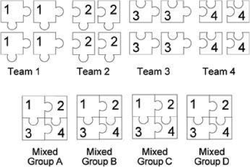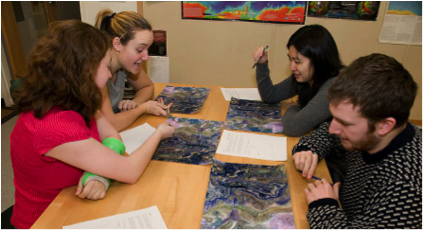What is a Jigsaw?
The jigsaw is known as a cooperative learning strategy. Jigsaw involves each student as part of a “home” group that becomes a specialist or expert on one aspect of a topic. “Students meet with members from other groups who are assigned the same aspect, and after mastering the material, return to the “home” group and teach the material to their group members (Reading Rockets, 2012). The jigsaw strategy involves each student’s part acting as a piece of the overall final product, or the puzzle. This strategy can be integrated in a variety of content areas. An example of this strategy in math when students are learning about fractions might include groups focusing on adding fractions, subtracting fractions, multiplying fractions, and dividing fractions (Manis, 2012). Jigsaw is beneficial for all students because it promotes self-guided learning in which each student takes ownership while working as part of a team.
A jigsaw generally involves:
The jigsaw is known as a cooperative learning strategy. Jigsaw involves each student as part of a “home” group that becomes a specialist or expert on one aspect of a topic. “Students meet with members from other groups who are assigned the same aspect, and after mastering the material, return to the “home” group and teach the material to their group members (Reading Rockets, 2012). The jigsaw strategy involves each student’s part acting as a piece of the overall final product, or the puzzle. This strategy can be integrated in a variety of content areas. An example of this strategy in math when students are learning about fractions might include groups focusing on adding fractions, subtracting fractions, multiplying fractions, and dividing fractions (Manis, 2012). Jigsaw is beneficial for all students because it promotes self-guided learning in which each student takes ownership while working as part of a team.
A jigsaw generally involves:
- Introducing the strategy and topic
- Assigning each student to a “home group” of 3-5 students with a range of abilities
- Dividing the segments or readings among the students
- Creating “expert groups” consisting of students across “home groups”
- Having students discuss main points of their segments
- Providing questions to help “expert groups” gather information
- Bringing students back into their “home groups”
- Asking each student to present segment to “home group”
Visual Representations

This graphic is a visual representation of what a jigsaw might look like with 16 students. Students in Team 1 all read the same article, for example, and they become the expert on their article. Then each team is split up and they are now in a mixed group with students from other original groups.
|
The link to the right shows it’s viewers one way how to use the Jigsaw reading strategy in a classroom. In this example, students are divided into four equal groups and they are each given their own article to read. Students in their group read the article and talk about important parts with their group members. Then each student is placed in a new group and they share what their article is about. Each student in the new group read a different article. Finally, the students are given an assessment about what they learned from each group. Students must trust and rely on each other that each group member is providing a good amount of information.
|
|
|
This picture is a group of older students in their home group at the same image. They are discussing what they see on the image, and then later they will share their findings with their expert group. These students are also given a graphic organizer, and they put important information on their organizer that they want to share with their expert group. Using a graphic organizer is a good idea for a jigsaw because it helps students organize their thoughts, and keeps them on task if they have something to write down.
|
|
This video example sets up their jigsaw a little differently. In this example, students begin in their home group where everyone has a different topic. Students read their individual topic and take notes. Then, students move into their expert group to discuss what they learned even further. After, students then move back to their home group to share what they learned in their expert group.
|
|
Content Area Examples
Science- This could be adapted by reading an article about a science related topic. Although it doesn’t deal with reading, another possible way to do something like a jigsaw in a science classroom, is to do it with science experiments. For example if students are learning about water, one group could conduct an experiment about the boiling point. This group would then report their findings to other groups whom are conducting different experiments about water.
Math- Jigsaw could be adapted for a math lesson by the teacher assigning each student to a paragraph or two. Then the students may summarize to the class what they had read. Once they are done summarizing the unit, the teacher can assign each student to a math problem from the unit. Each student can go up to the board and solve the problem and explain their strategy as to how they solved the problem.
History- This could be adapted by the teacher assigning each student to a page in their history book. The students will then read their page and take note of main ideas or keywords. Then, the teacher will call the class back as a whole group, and in order, the students will summarize their page. This strategy could be done with a newspaper or an article as well. It is hard for students to stay engaged while reading a history book. This strategy will help them stay engaged by not having to read the whole chapter, but still learn all the material.
Reading- Jigsaw is a great strategy for students to use to stay engaged in the reading and really understand what is being read. The teacher can assign each student to a different part in the book or story. The students will get up in front of the class and present their part by summarizing what they read.
Science- This could be adapted by reading an article about a science related topic. Although it doesn’t deal with reading, another possible way to do something like a jigsaw in a science classroom, is to do it with science experiments. For example if students are learning about water, one group could conduct an experiment about the boiling point. This group would then report their findings to other groups whom are conducting different experiments about water.
Math- Jigsaw could be adapted for a math lesson by the teacher assigning each student to a paragraph or two. Then the students may summarize to the class what they had read. Once they are done summarizing the unit, the teacher can assign each student to a math problem from the unit. Each student can go up to the board and solve the problem and explain their strategy as to how they solved the problem.
History- This could be adapted by the teacher assigning each student to a page in their history book. The students will then read their page and take note of main ideas or keywords. Then, the teacher will call the class back as a whole group, and in order, the students will summarize their page. This strategy could be done with a newspaper or an article as well. It is hard for students to stay engaged while reading a history book. This strategy will help them stay engaged by not having to read the whole chapter, but still learn all the material.
Reading- Jigsaw is a great strategy for students to use to stay engaged in the reading and really understand what is being read. The teacher can assign each student to a different part in the book or story. The students will get up in front of the class and present their part by summarizing what they read.

